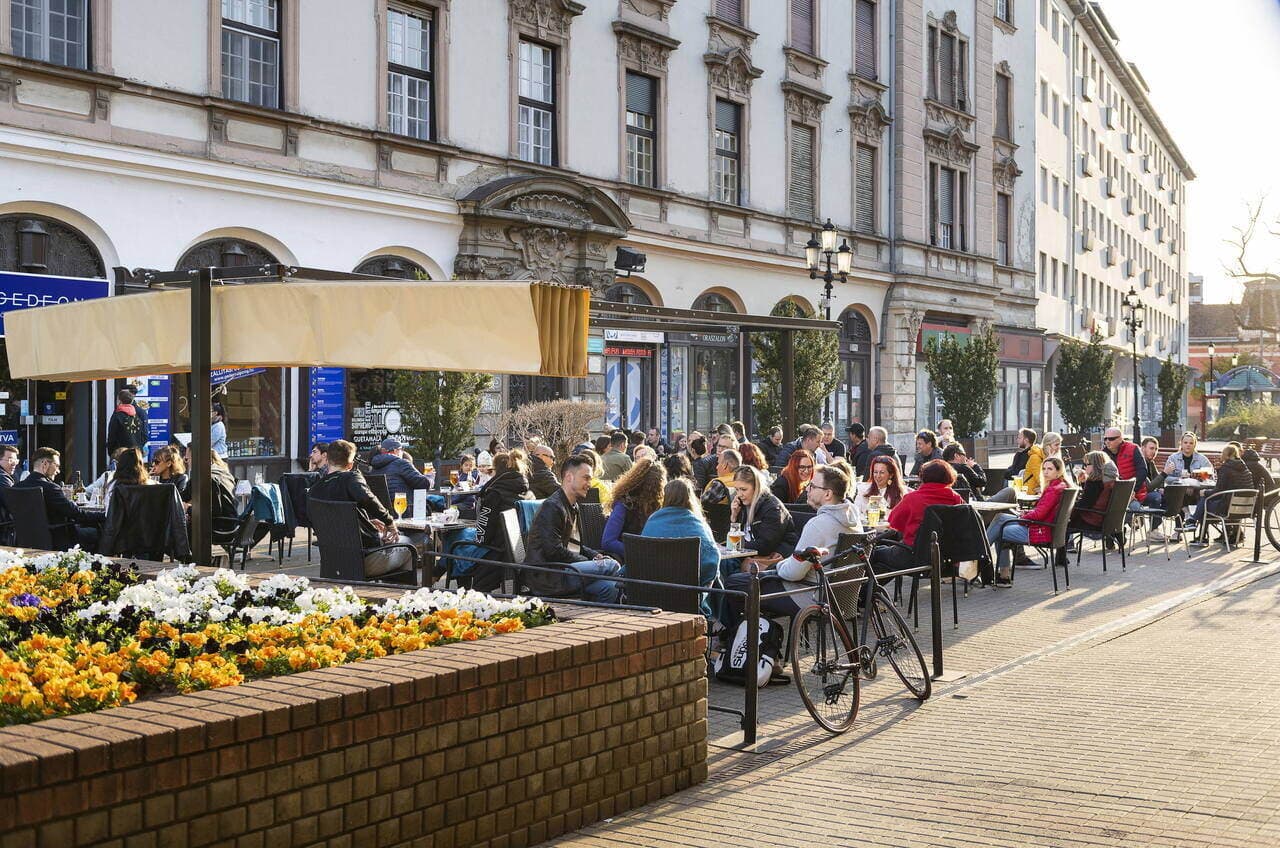As vaccination programmes began in the West, many journalists predicted that we were set to enter a second “Summer of Love” or perhaps a brand-new decade of the “Roaring Twenties”. After Hungary started lifting its restrictions, the scenery that followed clearly shows that there is something to these arguments. But will the euphoric feeling hold on, and if so, what would the social consequences be?
The last weekend of April was certainly something to remember, especially for those fortunate enough to have taken a walk through downtown Budapest. It was the beginning of the first phase of the easing of restrictions as more than 40 per cent of the country’s population had received their first dose of vaccination. Among the new regulations, there was one that especially gave way for wider celebration: the opening of pubs, bars and entertainment facilities, as long as they could set up outdoor seating areas or terraces.
As soon as the decree came into effect, a wave of euphoric joy swept over the country,
and quite understandably so. Bars were more or less closed for over a year now and people—especially the younger generation—were craving a beer in the company of their friends and outside their homes. So, on Saturday—despite the still relatively high number of infections—downtown Budapest has resembled one giant festival – with every terrace packed with cheerful young people dressed in colourful clothes and different kinds of music infused with the constant clanking of glasses coming from every direction.
It certainly was a sight to see! As young people flocked to the more popular outdoor bars, I could not help but notice some patterns I felt were new to me. Of course, this feeling of novelty must be attributed to a certain degree to the fact that we all became accustomed to the lockdown measures, but it quickly became apparent that something did change during this year of involuntary recess. At first glance, the general atmosphere seemed different, and in a more positive way.
A sense of relief and excitement could be felt everywhere I went. People seemed more open, outgoing and cheerful than I remembered. Even the larger groups were eager to interact with each other: everybody was ready to make new friends. Fashion also seemed to have undergone certain changes, as more people whom I talked to have noted. Tight jeans and shirts have all but disappeared from the wardrobes of young adults and were replaced by wide bottom jeans, colourful harem pants with baggy shirts and oversized tees. Likewise, the solid colours we were used to were nowhere to be found, but instead, people opted for the more vivid and bright pieces. And because they had no occasion to show off their style this past year, everyone was also sporting some kind of unique accessory on top of that. A city-wide fashion show, it seemed.
The excessive drinking was in no way anything surprising, as these people have gathered to do just that. However, the constant smell of weed near almost every pub made me wonder a bit. The substance is still highly illegal in Hungary and before the Covid-19 pandemic, people—fearing the authorities—would generally restrain themselves from smoking it publicly. This time it was different: one could easily see multiple lit joints being passed around at any given time, if the smell itself wasn’t making it obvious enough.
This scenery immediately reminded me of pictures from the late sixties, the golden age of the hippie movement in the US and Western Europe. The specific clothing choices and the overt use of light drugs are not the only factors contributing to this comparison, merely the most apparent ones. There is also the general idea of seeking fun like there is no tomorrow. Judging from this, when indoor clubs join the bars and open up their doors for the depraved party-goers, it is quite possible that another ‘Summer of Love’ is going to erupt in most Western countries, drowning the unpleasant memories of the pandemic in cheap beer and dubious party drugs.
The other comparison I have seen being brought up over and over is of course about the “Roaring Twenties” of the last century, which is quite fitting as we just entered our Twenties last year. The argument here, made by The Guardian among others, is that this celebration-like atmosphere we have just witnessed in Hungary could drag on for years, laying down the social character of the whole decade. The 1920s, indeed, were a time of splendour, champagne and social gatherings of grandiose scale, all symptoms of a sense of relief only terrible global crises could leave. The First World War and the subsequent Spanish Flu pandemic were more than enough to evoke such a reaction, and one could say we are in quite a similar position now. After all, the pandemic part is quite an obvious parallel. But is it enough?
Zack Stanton, editor of POLITICO, the American political news journal, argues that it may not be the case this time.
As he writes, ‘behind the flappers, bootleggers and Gatsbyesque decadence was a hard-won fatalism that came from the level of loss and devastation wrought by the war and the flu, which–unlike Covid–disproportionately killed younger Americans, contributing to a sense among some who survived that since they could die young, they might as well live hard.’ In 2021 there is an unquestionable sense of relief, but we are nowhere near the “fatalism” Stanton described. There was no devastating global war and the death rate of COVID-19 is not even comparable to that of the Spanish Flu, thanks to advanced tools of crisis management and effective vaccinations. Of course, I would never try to downplay the traumatic experiences of those who had lost loved ones to Covid (myself being among them), but our society as whole did not have to go through as brutal hardships as people in the 1910s did. I mean, no one is going to write another “In Flanders Fields” about the horrors of toilet paper shortages and bad connections during Zoom-meetings. Hence, I think Stanton’s right and chances for a decade long drunken celebration are rather small.
Still, I can easily see this summer being the extended version of the above described weekend in Budapest. A months-long festival of the free and careless. And while it sounds great in theory, it could also have some unpleasant consequences. The famous “Summer of Love” of 1967 (and its legacy carried on for years) had quite an infamous dark side to it as well. Alcohol poisoning and drug overdoses were part and parcel of the hippie culture and the events associated with it, and so were the skyrocketing of STD cases. As Dr David Smith, founder of the Haight-Ashbury Free Clinic described the period, ‘there was a lot of drug use, group sex, communal sex. It would be an understatement to say there was a spike in STDs. That’s like saying a hurricane is a strong wind.’
Since the last season was cancelled and young adults had to stay indoors ever since, most of them want nothing more than to go to as many parties and festivals as they can this summer. It is safe to assume that this year’s festivals will be especially wild, inducing some of the negative effects seen in 1967, even if on a smaller scale. I would be not surprised if instead of COVID-19 patients, the hospitals would be full of kids awaiting detoxication.
But to end this article on a happy note, I think we may need these parties after all, to properly put the pandemic behind us. And as far as it goes, we really do have reasons to celebrate once herd immunity is reached in the coming weeks throughout the West. Until then, we might as well purchase a pair of baggy pants and remember not to accept drinks from strangers. Just in case.








